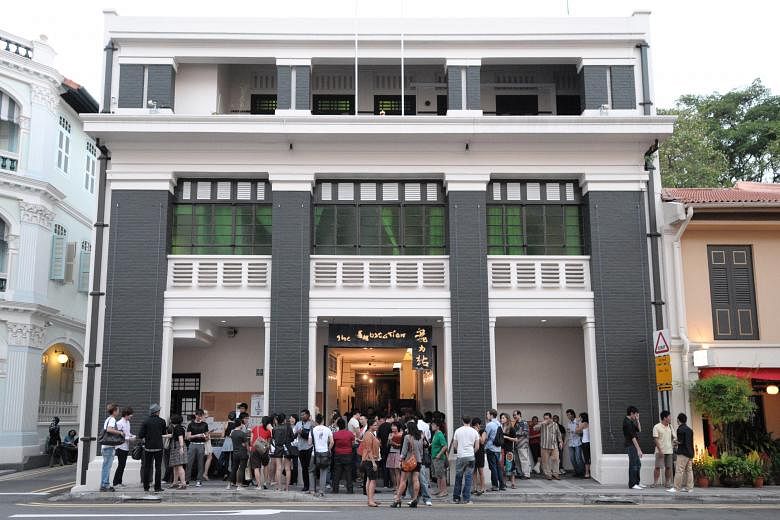A spirited debate has divided arts practitioners in Singapore over the future and identity of The Substation, one of the few independent arts spaces here, in the wake of changes announced by its new artistic director, Alan Oei.
Oei, who was named artistic director last October, has said in media interviews that he intends to phase out venue rental, review programming and change how the building's spaces are used.
The current dance studio, for example, will be repurposed as a gallery.
Some see it as the demise of an institution known as a beacon for edgy and experimental art, while others appreciate Oei's renewed vision and efforts to make the centre financially viable.
The idea of turning the disused power substation at Armenian Street into an arts centre was mooted by its founder, the late theatre giant Kuo Pao Kun, in the 1990s.
Its previous artistic directors include T. Sasi- tharan (1995 to 2000), former Straits Times arts editor and theatre practitioner; arts administrator and educator Audrey Wong and art critic Lee Weng Choy (artistic co- directors from 2000 to 2010) and, most recently, director Noor Effendy Ibrahim (2010 to 2015).
Over the years, each built on Kuo's vision of The Substation as an open, plural place where artists of different disciplines could meet to debate and create art.
Limiting the wide-ranging use of venues flies in the face of Kuo's original vision, says poet Cyril Wong, who was a programme manager at The Substation from 2002 to 2008 and has also performed there.
He says: "The subsidised rates allowed artists to rent an affordable venue and innovate.
"Artists conducted all kinds of talks, dance experimentations, visual art expressions in small spaces including the foyer, dance studio and classrooms. Without a wide-ranging use of the venues, a lack of diversity and inclusiveness will happen."
Some live music lovers have lamented Oei's choice to gradually ease out venue rental at The Substation, which has hosted all kinds of music events from music history exhibitions to jazz performances and indie rock concerts.
Quoting from a note he had earlier written, gig organiser Shaiful Risan, who often holds events at The Substation, tells The Straits Times that there is a "dearth" of spaces available for live music, especially noisier events, in an increasingly gentrified Singapore.
"The noisy people are part of society and they, too, need a playground," he says.
Film-maker Jasmine Ng recalls how The Substation has nurtured the independent film scene since the early 1990s.
Its Moving Images film programme ended earlier this month without any notice given to the film community and was later explained as "part of efforts to programme all genres and disciplines in unison and as part of a larger picture", Oei wrote in a statement on Facebook.
Ng says: "There are more short films now and we do have other screening spaces such as Objectifs and The Projector. But do we have a venue which caters to a diverse range of films, showcasing raw and experimental works? The Substation was that place."
To address the concerns, The Substation will hold talks every Tuesday until March 22, held in small group sessions. It will release more information online every Friday on its Facebook page till March 18, culminating in a townhall session on March 31.
Oei says in an e-mail interview with The Straits Times: "I feel we haven't communicated many concrete aspects of the vision, so people have been worried. That's understandable.
"We could be shapeshifting, reinventing how we use the space and what kind of programmes and functions can occur.
"In this time of reexamination, venue rental will still be around for the next two years. Will it still be around after that? I'd like us to find the answer together once we separate the idea of plurality and inclusivity from venue rental."
The artistic director of The Necessary Stage, Alvin Tan, says The Substation, which was originally a ground-up initiative, is seen as "something which belongs to the community, so rightly, people feel possessive over it".
His theatre company's 1990 play, Those Who Can't, Teach, was the first theatre production staged there.
"If you have that idealism and you want community ownership, put your money where your mouth is and be responsible for it. It's just like with Timbre - people complained but no one volunteered to share the stakes so that The Substation could keep the garden," he adds, referring to how a 360 sq m garden in The Substation, once used for arts events, was rented out to the restaurant and live music bar in 2005.
Ng believes the greater discourse now should focus on the meaning of sustainability in a city of high rentals, and the affordability and accessibility of independent spaces to all arts groups.
"Common spaces such as community centres are also not financially sustainable. Does this mean we stop running them too? The Substation allowed different kinds of expression to thrive. Now, if you make art that may not be popular, where will you go to show it?"
• Send your views to stlife@sph.com.sg



